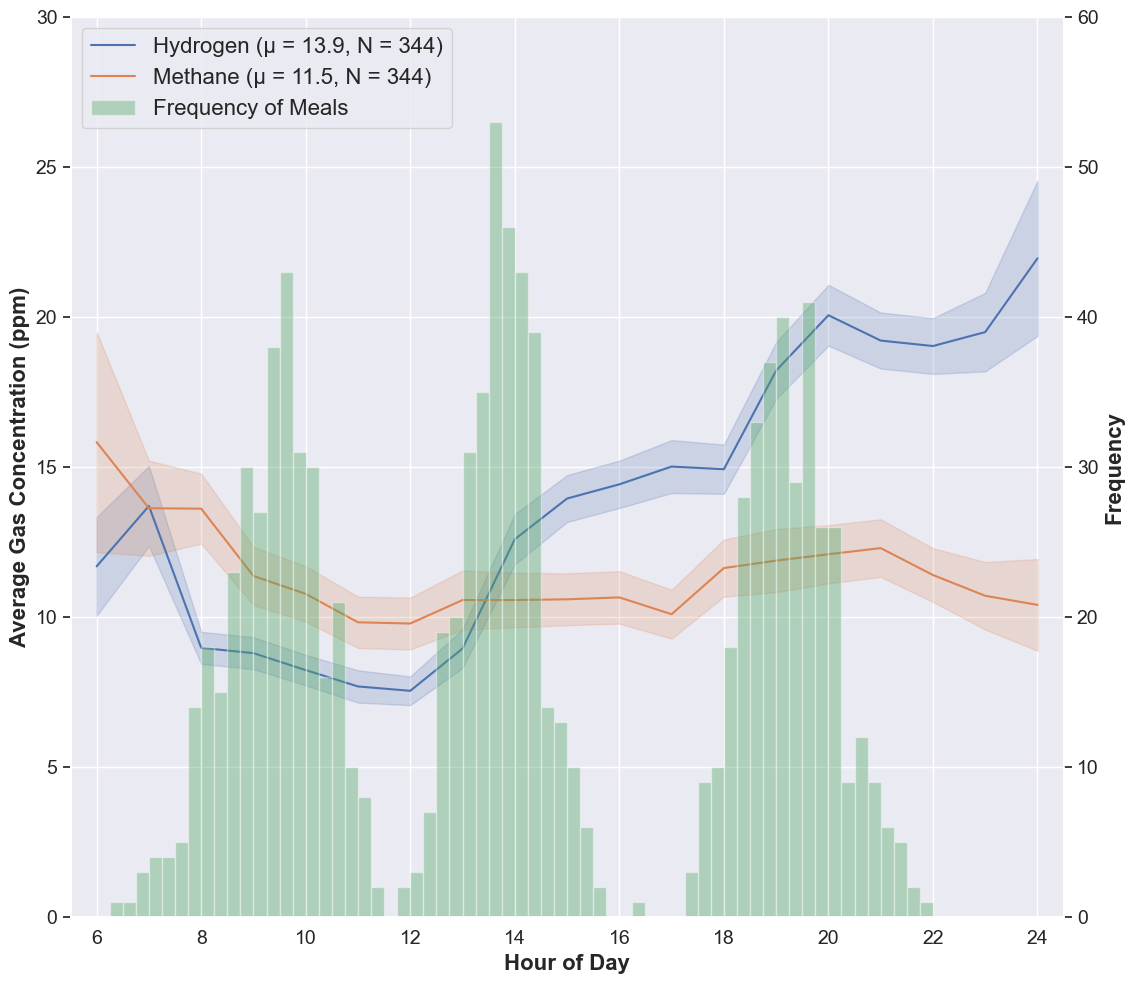Tuesday Poster Session
Category: Diet, Nutrition, and Obesity
P4833 - Diurnal Variation in Breath Hydrogen and Methane Reflects Meal Timing in a Large Real-World Cohort
Tuesday, October 28, 2025
10:30 AM - 4:00 PM PDT
Location: Exhibit Hall

Eamonn M. Quigley, MD, MACG (he/him/his)
Houston Methodist Hospital
Houston, TX
Presenting Author(s)
Eamonn M.. Quigley, MD, MACG1, Madeline Berschback, MD2, Barry McBride, MSc3, Robert Burke, MSc3, Claire Shortt, PhD3, Aonghus Shortt, PhD3, Cillian Murphy, 4, Kyle Staller, MD, MPH2
1Houston Methodist Hospital, Houston, TX; 2Massachusetts General Hospital, Boston, MA; 3FoodMarble, Dublin, Dublin, Ireland; 4FoodMarble Digestive Health Ltd, Dublin, Dublin, Ireland
Introduction: Fermentation of undigested carbohydrates by colonic microbes produces hydrogen (H₂) and methane (CH₄), which can be measured as changes in these breath gases. While a distinct diurnal pattern in post-prandial breath H₂ and CH₄ has been previously described, the influence of meal timing on these fluctuations remains less understood. In this study, we aim to investigate how the timing of food intake affects the production and exhalation patterns of non-fasting breath H₂ and CH₄.
Methods: We retrospectively analyzed breath H₂ and CH₄ data from 344 (57% female, average BMI 24 ± 5 kg/m2, Age 46 ± 12 years) users of a personal app-connected breath analyzer (AIRE®, FoodMarble, Dublin, Ireland). Participants recorded breath gas levels and meals over a single day while consuming their habitual diet. Only individuals who recorded at least three meals per day and a minimum daily energy intake of 1500 kcal were included. Average hourly H₂ and CH₄ concentrations were calculated alongside frequency of reported meals. Mean concentrations and standard error of the mean (SEM) were plotted to examine diurnal patterns in relation to eating behavior. One-way repeated measures ANOVA was used to assess differences in gas concentrations across time points.
Results: Meal frequency exhibited a clear tri-modal distribution, peaking around traditional breakfast, lunch, and dinner times. Breath concentrations of both gases declined before rising and exhibited different diurnal patterns thereafter, with breath H₂ exhibiting a marked post-prandial rise following lunch (p < 0.001) and dinner (p < 0.001) but not breakfast and then peaking in the late afternoon and evening. In contrast, CH₄ levels remained relatively stable over the day with non-significant increases after lunch (p = 0.5) and dinner (p = 0.4). The temporal alignment of H₂ elevation with the main meal periods suggests a strong post-prandial fermentation response.
Discussion: This large-scale, real-world analysis demonstrates that breath H₂, but not CH₄, profiles are influenced by meal ingestion. These findings underscore the utility of post-prandial breath H₂ and CH₄ measurements in evaluating colonic fermentation response to food intake throughout the day. Future research could explore how these patterns vary in individuals with specific gastrointestinal disorders and also assess patient responsiveness to dietary interventions.

Figure: Mean Diurnal Breath H₂ and CH₄ Levels in Relation to Meal Timing
Disclosures:
Eamonn Quigley: Food Marble – Advisor or Review Panel Member.
Madeline Berschback indicated no relevant financial relationships.
Barry McBride: FoodMarble Digestive Health – Employee.
Robert Burke: FoodMarble Digestive Health – Employee.
Claire Shortt: FoodMarble Digestive Health – Employee.
Aonghus Shortt: FoodMarble Digestive Health – Owner/Ownership Interest.
Cillian Murphy: FoodMarble Digestive Health – Employee.
Kyle Staller: Ardelyx – Grant/Research Support. Gemelli – Consultant. Laborie – Consultant. Mahana – Consultant. Salix – Consultant. Takeda – Expert witness.
Eamonn M.. Quigley, MD, MACG1, Madeline Berschback, MD2, Barry McBride, MSc3, Robert Burke, MSc3, Claire Shortt, PhD3, Aonghus Shortt, PhD3, Cillian Murphy, 4, Kyle Staller, MD, MPH2. P4833 - Diurnal Variation in Breath Hydrogen and Methane Reflects Meal Timing in a Large Real-World Cohort, ACG 2025 Annual Scientific Meeting Abstracts. Phoenix, AZ: American College of Gastroenterology.
1Houston Methodist Hospital, Houston, TX; 2Massachusetts General Hospital, Boston, MA; 3FoodMarble, Dublin, Dublin, Ireland; 4FoodMarble Digestive Health Ltd, Dublin, Dublin, Ireland
Introduction: Fermentation of undigested carbohydrates by colonic microbes produces hydrogen (H₂) and methane (CH₄), which can be measured as changes in these breath gases. While a distinct diurnal pattern in post-prandial breath H₂ and CH₄ has been previously described, the influence of meal timing on these fluctuations remains less understood. In this study, we aim to investigate how the timing of food intake affects the production and exhalation patterns of non-fasting breath H₂ and CH₄.
Methods: We retrospectively analyzed breath H₂ and CH₄ data from 344 (57% female, average BMI 24 ± 5 kg/m2, Age 46 ± 12 years) users of a personal app-connected breath analyzer (AIRE®, FoodMarble, Dublin, Ireland). Participants recorded breath gas levels and meals over a single day while consuming their habitual diet. Only individuals who recorded at least three meals per day and a minimum daily energy intake of 1500 kcal were included. Average hourly H₂ and CH₄ concentrations were calculated alongside frequency of reported meals. Mean concentrations and standard error of the mean (SEM) were plotted to examine diurnal patterns in relation to eating behavior. One-way repeated measures ANOVA was used to assess differences in gas concentrations across time points.
Results: Meal frequency exhibited a clear tri-modal distribution, peaking around traditional breakfast, lunch, and dinner times. Breath concentrations of both gases declined before rising and exhibited different diurnal patterns thereafter, with breath H₂ exhibiting a marked post-prandial rise following lunch (p < 0.001) and dinner (p < 0.001) but not breakfast and then peaking in the late afternoon and evening. In contrast, CH₄ levels remained relatively stable over the day with non-significant increases after lunch (p = 0.5) and dinner (p = 0.4). The temporal alignment of H₂ elevation with the main meal periods suggests a strong post-prandial fermentation response.
Discussion: This large-scale, real-world analysis demonstrates that breath H₂, but not CH₄, profiles are influenced by meal ingestion. These findings underscore the utility of post-prandial breath H₂ and CH₄ measurements in evaluating colonic fermentation response to food intake throughout the day. Future research could explore how these patterns vary in individuals with specific gastrointestinal disorders and also assess patient responsiveness to dietary interventions.

Figure: Mean Diurnal Breath H₂ and CH₄ Levels in Relation to Meal Timing
Disclosures:
Eamonn Quigley: Food Marble – Advisor or Review Panel Member.
Madeline Berschback indicated no relevant financial relationships.
Barry McBride: FoodMarble Digestive Health – Employee.
Robert Burke: FoodMarble Digestive Health – Employee.
Claire Shortt: FoodMarble Digestive Health – Employee.
Aonghus Shortt: FoodMarble Digestive Health – Owner/Ownership Interest.
Cillian Murphy: FoodMarble Digestive Health – Employee.
Kyle Staller: Ardelyx – Grant/Research Support. Gemelli – Consultant. Laborie – Consultant. Mahana – Consultant. Salix – Consultant. Takeda – Expert witness.
Eamonn M.. Quigley, MD, MACG1, Madeline Berschback, MD2, Barry McBride, MSc3, Robert Burke, MSc3, Claire Shortt, PhD3, Aonghus Shortt, PhD3, Cillian Murphy, 4, Kyle Staller, MD, MPH2. P4833 - Diurnal Variation in Breath Hydrogen and Methane Reflects Meal Timing in a Large Real-World Cohort, ACG 2025 Annual Scientific Meeting Abstracts. Phoenix, AZ: American College of Gastroenterology.
